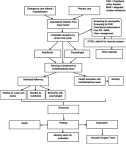Prognosis of the outcome of severe diabetic foot ulcers with multidisciplinary care
- PMID: 31118658
- PMCID: PMC6506632
- DOI: 10.2147/JMDH.S194969
Prognosis of the outcome of severe diabetic foot ulcers with multidisciplinary care
Abstract
Background: Approximately 2-4% of individuals worldwide with diabetes mellitus have foot ulcers. This study aims to assess the factors affecting the outcomes of severe foot ulcers in diabetic individuals. Methods: An analytical prospective cohort study was conducted from March 1st, 2015, to March 1st, 2017. A total of 34 individuals was selected. The study included patients with foot ulcers below the ankle who were at risk of amputation. All tests used a <5% level of significance and confidence interval of 95%. A Pearson's chi-squared test and binary multiple regression were performed to assess the factors related to healing. Results: Only 11.7% of the individuals required amputation; ulcers classified as 2/B according to the University of Texas Diabetic Foot Ulcer Classification System healed before the 1/B ulcers. Neuropathic ulcers were the most prevalent (58.8%); 61.8% healed after 1 year. Most of the individuals were overweight, 47.1% had reduced glomerular filtration rates, and 78.8% had glycated hemoglobin >7%. Body mass index and osteomyelitis were the two significant variables in logistic regression. Conclusions: In this study, osteomyelitis was the main complication related to the risk of amputation, and elevated body mass index and osteomyelitis were the significant factors that induced a slower healing time.
Keywords: diabetes complications; diabetes mellitus; diabetic foot; multidisciplinary care.
Conflict of interest statement
The authors report no conflicts of interest in this work.
Figures
Similar articles
-
Proximal Tibial Cortex Transverse Distraction Facilitating Healing and Limb Salvage in Severe and Recalcitrant Diabetic Foot Ulcers.Clin Orthop Relat Res. 2020 Apr;478(4):836-851. doi: 10.1097/CORR.0000000000001075. Clin Orthop Relat Res. 2020. PMID: 31794478 Free PMC article.
-
[Recurrence and influencing factors of diabetic foot ulcer in patients with type 2 diabetes mellitus].Zhonghua Shao Shang Za Zhi. 2020 Oct 20;36(10):947-952. doi: 10.3760/cma.j.cn501120-20190726-00315. Zhonghua Shao Shang Za Zhi. 2020. PMID: 33105947 Chinese.
-
Predictors of Outcomes of Foot Ulcers among Individuals with Type 2 Diabetes Mellitus in an Outpatient Foot Clinic.J ASEAN Fed Endocr Soc. 2021;36(2):189-195. doi: 10.15605/jafes.036.02.14. Epub 2021 Oct 5. J ASEAN Fed Endocr Soc. 2021. PMID: 34966204 Free PMC article.
-
Nutritional interventions for treating foot ulcers in people with diabetes.Cochrane Database Syst Rev. 2020 Jul 17;7(7):CD011378. doi: 10.1002/14651858.CD011378.pub2. Cochrane Database Syst Rev. 2020. PMID: 32677037 Free PMC article.
-
Treatment of diabetic foot ulcers.J Cardiovasc Surg (Torino). 2009 Jun;50(3):275-91. J Cardiovasc Surg (Torino). 2009. PMID: 19543189 Review.
Cited by
-
Auto-Administered Photobiomodulation on Diabetic Leg Ulcers Treatment: A New Way to Manage It?Case Rep Med. 2020 May 20;2020:7428472. doi: 10.1155/2020/7428472. eCollection 2020. Case Rep Med. 2020. PMID: 32518562 Free PMC article.
-
Translational development of ABCB5+ dermal mesenchymal stem cells for therapeutic induction of angiogenesis in non-healing diabetic foot ulcers.Stem Cell Res Ther. 2022 Sep 5;13(1):455. doi: 10.1186/s13287-022-03156-9. Stem Cell Res Ther. 2022. PMID: 36064604 Free PMC article. Clinical Trial.
-
Amputation rate of diabetic foot ulcer and associated factors in diabetes mellitus patients admitted to Nekemte referral hospital, western Ethiopia: prospective observational study.J Foot Ankle Res. 2020 Nov 4;13(1):65. doi: 10.1186/s13047-020-00433-9. J Foot Ankle Res. 2020. PMID: 33148292 Free PMC article.
-
Machine learning for the prediction of minor amputation in University of Texas grade 3 diabetic foot ulcers.PLoS One. 2022 Dec 6;17(12):e0278445. doi: 10.1371/journal.pone.0278445. eCollection 2022. PLoS One. 2022. PMID: 36472981 Free PMC article.
-
The Influence of 6-Month Interdisciplinary Accompaniment on Family Caregivers' Knowledge and Self-Efficacy Regarding Diabetic Wound Care.SAGE Open Nurs. 2023 Apr 6;9:23779608231167801. doi: 10.1177/23779608231167801. eCollection 2023 Jan-Dec. SAGE Open Nurs. 2023. PMID: 37050936 Free PMC article.
References
-
- Canadian Association of Wound Care (Wounds Canada). Foundations of Best Practice for Skin and Wound Management: Best Practice Recommendations for the Prevention and Management of Diabetic Foot Ulcers. North York: Wounds Canada; 2018. 68 Available from: https://www.woundscanada.ca/docman/public/health-care-professional/bpr-w.... Accessed November 8, 2018.
-
- Oliveira JEP, Vencio S. [Guidelines of the Brazilian Diabetes Society: 2014–2015]. Oliveira JEP, Vencio S, editors. São Paulo: AC Pharmaceuticals; 2016. Portuguese.
LinkOut - more resources
Full Text Sources



